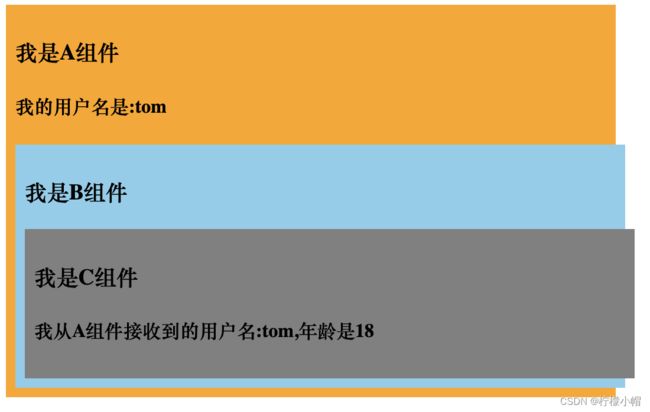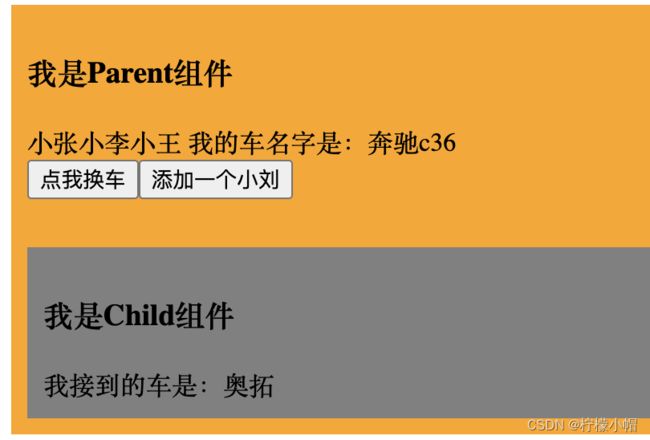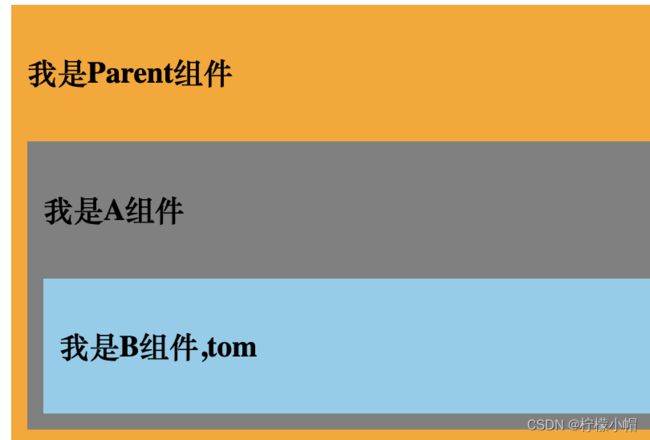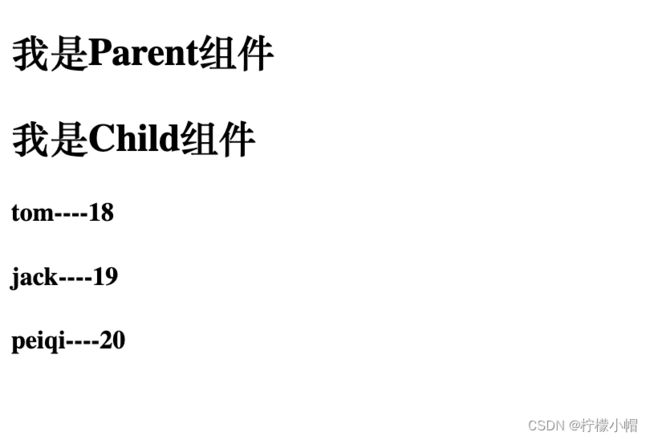React 全栈体系(十六)
第八章 React 扩展
五、Context
1. 代码
/* index.jsx */
import React, { Component } from 'react'
import './index.css'
//创建Context对象
const MyContext = React.createContext()
const {Provider,Consumer} = MyContext
export default class A extends Component {
state = {username:'tom',age:18}
render() {
const {username,age} = this.state
return (
<div className="parent">
<h3>我是A组件</h3>
<h4>我的用户名是:{username}</h4>
<Provider value={{username,age}}>
<B/>
</Provider>
</div>
)
}
}
class B extends Component {
render() {
return (
<div className="child">
<h3>我是B组件</h3>
<C/>
</div>
)
}
}
/* class C extends Component {
//声明接收context
static contextType = MyContext
render() {
const {username,age} = this.context
return (
我是C组件
我从A组件接收到的用户名:{username},年龄是{age}
)
}
} */
function C(){
return (
<div className="grand">
<h3>我是C组件</h3>
<h4>我从A组件接收到的用户名:
<Consumer>
{value => `${value.username},年龄是${value.age}`}
</Consumer>
</h4>
</div>
)
}
2. 总结
- 理解
一种组件间通信方式, 常用于【祖组件】与【后代组件】间通信
- 使用
1) 创建Context容器对象:
const XxxContext = React.createContext()
2) 渲染子组件时,外面包裹xxxContext.Provider, 通过value属性给后代组件传递数据:
<xxxContext.Provider value={数据}>
子组件
</xxxContext.Provider>
3) 后代组件读取数据:
//第一种方式:仅适用于类组件
static contextType = xxxContext // 声明接收context
this.context // 读取context中的value数据
//第二种方式: 函数组件与类组件都可以
<xxxContext.Consumer>
{
value => ( // value就是context中的value数据
要显示的内容
)
}
</xxxContext.Consumer>
- 注意
在应用开发中一般不用 context, 一般都用它的封装 react 插件
六、组件优化
1. Component 的 2 个问题
- 只要执行 setState(),即使不改变状态数据, 组件也会重新 render() ==> 效率低
- 只当前组件重新 render(), 就会自动重新 render 子组件,纵使子组件没有用到父组件的任何数据 ==> 效率低
2. 效率高的做法
- 只有当组件的 state 或 props 数据发生改变时才重新 render()
3. 原因
- Component 中的 shouldComponentUpdate()总是返回 true
4. 解决
办法1:
重写shouldComponentUpdate()方法
比较新旧state或props数据, 如果有变化才返回true, 如果没有返回false
办法2:
使用PureComponent
PureComponent重写了shouldComponentUpdate(), 只有state或props数据有变化才返回true
注意:
只是进行state和props数据的浅比较, 如果只是数据对象内部数据变了, 返回false
不要直接修改state数据, 而是要产生新数据
项目中一般使用PureComponent来优化
5. 代码
/* src/App.jsx */
import React, { PureComponent } from 'react'
import './index.css'
export default class Parent extends PureComponent {
state = {carName:"奔驰c36",stus:['小张','小李','小王']}
addStu = ()=>{
/* const {stus} = this.state
stus.unshift('小刘')
this.setState({stus}) */
const {stus} = this.state
this.setState({stus:['小刘',...stus]})
}
changeCar = ()=>{
//this.setState({carName:'迈巴赫'})
const obj = this.state
obj.carName = '迈巴赫'
console.log(obj === this.state);
this.setState(obj)
}
/* shouldComponentUpdate(nextProps,nextState){
// console.log(this.props,this.state); //目前的props和state
// console.log(nextProps,nextState); //接下要变化的目标props,目标state
return !this.state.carName === nextState.carName
} */
render() {
console.log('Parent---render');
const {carName} = this.state
return (
<div className="parent">
<h3>我是Parent组件</h3>
{this.state.stus}
<span>我的车名字是:{carName}</span><br/>
<button onClick={this.changeCar}>点我换车</button>
<button onClick={this.addStu}>添加一个小刘</button>
<Child carName="奥拓"/>
</div>
)
}
}
class Child extends PureComponent {
/* shouldComponentUpdate(nextProps,nextState){
console.log(this.props,this.state); //目前的props和state
console.log(nextProps,nextState); //接下要变化的目标props,目标state
return !this.props.carName === nextProps.carName
} */
render() {
console.log('Child---render');
return (
<div className="child">
<h3>我是Child组件</h3>
<span>我接到的车是:{this.props.carName}</span>
</div>
)
}
}
/* src/index.css */
.parent{
background-color: orange;
padding: 10px;
}
.child{
background-color: gray;
margin-top: 30px;
padding: 10px;
}
七、renderProps
1. 如何向组件内部动态传入带内容的结构(标签)?
- Vue 中:
- React 中:
- 使用 children props: 通过组件标签体传入结构
- 使用 render props: 通过组件标签属性传入结构,而且可以携带数据,一般用 render 函数属性
2. children props
<A>
<B>xxxx</B>
</A>
{this.props.children}
问题: 如果B组件需要A组件内的数据, ==> 做不到
3. render props
<A render={(data) => <C data={data}></C>}></A>
A组件: {this.props.render(内部state数据)}
C组件: 读取A组件传入的数据显示 {this.props.data}
4. 代码
/* src/App.jsx */
import React, { Component } from 'react'
import './index.css'
export default class Parent extends Component {
render() {
return (
<div className="parent">
<h3>我是Parent组件</h3>
<A render={(name)=><B name={name}/>}/>
</div>
)
}
}
class A extends Component {
state = {name:'tom'}
render() {
console.log(this.props);
const {name} = this.state
return (
<div className="a">
<h3>我是A组件</h3>
{this.props.render(name)}
</div>
)
}
}
class B extends Component {
render() {
console.log('B--render');
return (
<div className="b">
<h3>我是B组件,{this.props.name}</h3>
</div>
)
}
}
/* src/index.css */
.parent{
background-color: orange;
padding: 10px;
}
.a{
background-color: gray;
margin-top: 30px;
padding: 10px;
}
.b{
background-color: skyblue;
margin-top: 30px;
padding: 10px;
}
八、错误边界
1. 理解
- 错误边界(Error boundary):用来捕获后代组件错误,渲染出备用页面
2. 特点
- 只能捕获后代组件生命周期产生的错误,不能捕获自己组件产生的错误和其他组件在合成事件、定时器中产生的错误
3. 使用方式
- getDerivedStateFromError 配合 componentDidCatch
// 生命周期函数,一旦后台组件报错,就会触发
static getDerivedStateFromError(error) {
console.log(error);
// 在render之前触发
// 返回新的state
return {
hasError: true,
};
}
componentDidCatch(error, info) {
// 统计页面的错误。发送请求发送到后台去
console.log(error, info);
}
4. 代码
4.1 Child
/* src/Child.jsx */
import React, { Component } from 'react'
export default class Child extends Component {
state = {
users:[
{id:'001',name:'tom',age:18},
{id:'002',name:'jack',age:19},
{id:'003',name:'peiqi',age:20},
]
// users:'abc'
}
render() {
return (
<div>
<h2>我是Child组件</h2>
{
this.state.users.map((userObj)=>{
return <h4 key={userObj.id}>{userObj.name}----{userObj.age}</h4>
})
}
</div>
)
}
}
4.2 Parent
/* src/Parent.jsx */
import React, { Component } from 'react'
import Child from './Child'
export default class Parent extends Component {
state = {
hasError:'' //用于标识子组件是否产生错误
}
//当Parent的子组件出现报错时候,会触发getDerivedStateFromError调用,并携带错误信息
static getDerivedStateFromError(error){
console.log('@@@',error);
return {hasError:error}
}
componentDidCatch(){
console.log('此处统计错误,反馈给服务器,用于通知编码人员进行bug的解决');
}
render() {
return (
<div>
<h2>我是Parent组件</h2>
{this.state.hasError ? <h2>当前网络不稳定,稍后再试</h2> : <Child/>}
</div>
)
}
}
4.3 App
/* src/App.jsx */
import React, { Component,Fragment } from 'react'
import Demo from './Parent'
export default class App extends Component {
render() {
return (
<Fragment>
<Demo/>
</Fragment>
)
}
}
九、组件通信方式总结
1. 组件间的关系
- 父子组件
- 兄弟组件(非嵌套组件)
- 祖孙组件(跨级组件)
2. 几种通信方式
1.props:
(1).children props
(2).render props
2.消息订阅-发布:
pubs-sub、event等等
3.集中式管理:
redux、dva等等
4.conText:
生产者-消费者模式
3. 比较好的搭配方式
- 父子组件:props
- 兄弟组件:消息订阅-发布、集中式管理
- 祖孙组件(跨级组件):消息订阅-发布、集中式管理、Context(开发用的少,封装插件用的多)




